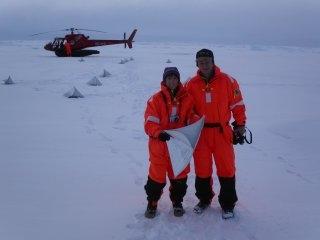26 August, 2004
Out on the Ice
It seems that my chance to actually go out onto the Arctic ice has finally
arrived! Anders Karlqvist, of the Swedish Polar Research Secretariat and
ACEX Information Officer, has asked if I would like some work to do. I've
learned that answering "yes" to that question will bring on a new adventure
and this is no exception.
There are silver radar detection targets that need to be
assembled and placed at specific points out on the ice. Satellites will
locate them and then using successive satellite pictures of the targets, the
Ice Management Team will be better able to track the movements of the sea
ice.
The targets are shipped folded flat in packages and need to be
assembled in their 3D configuration. The problem is that the assembly must
be done on-site because once put together there is no way that 60 or more of
them will be able to fit in the helicopter along with 5 people.
All dressed up in our orange survival suits we get into the
helicopter along with the packages of targets, wooden stakes, staplers, and
the GPS coordinates for placing the targets. There is a light snow blowing
as we take off for the first location. Arriving at that point Sven Stenval,
our helicopter pilot, gently lands the craft and then bounces it a few times
on the ice to make sure this part of the large ice floe will support our
weight. We lift off again; oops, apparently this is not a suitable landing
site. We set down again close by and get out with our equipment. At this
site we will set the targets out in a large "X" configuration. Sven and I
fold up the sides of the targets and tie them together to form their
triangular shape; the light wind is actually helpful in lifting the target's
4 sides upright for us. The targets are then stapled to small wooden stakes
pounded into the ice. When I take some of the assembled targets out to the
stakes they act as kites and help propel me along in the wind. I walk
gingerly on the snow-covered ice. I know that the ice is very thick below
me, but the water beneath the ice is very deep - 1200 meters or so! This
time of year some of the ice on top of the floes melts into "melt pools" and
then often refreezes. The little crackling noises I hear as I step across
the ice are just the cracking of the melt pool surface, but it is a bit
creepy and unnerving all the same. The little bit of unease I feel is
definitely outweighed by the experience of being out in the middle of an
ice-covered expanse as far as I can see. After the constant crashing sounds
of ice-breaking on the ship the silence here is unusual but a welcome
relief. In the far distance is the Sovetskiy Soyuz, but there is no sign of
my "home base", the Oden, from here.
We finish our duties at two more sites, each time placing the
targets in a new configuration. Before we leave the last location, I must
take a scramble up a 6' ice ridge to have my picture taken. It looks like
the sort of place that an "ice bear" might hide and even though I am keen to
see one, this is not the time; I ask my fellow teacher, Erik, to check that
there is no bear lurking there. It's safe so I climb up and pose for my
photo. Ulf Hedman, ACEX Logistics Coordinator, offers to take pictures of
the rest of the team and we willingly oblige and pose on the drift. After
sliding down and tossing a harmless snowball at Anders, it's time to head
back to the Oden and a hot cup of strong Swedish coffee.

Anders and I prepare to set out a radar reflector.

The radar reflectors arranged and waiting for the satellite.

Sven, Anders, me and Erik atop an ice pressure ridge on the Arctic Ocea n.
Contact the TEA in the field at
.
If you cannot connect through your browser, copy the
TEA's e-mail address in the "To:" line of
your favorite e-mail package.
|
